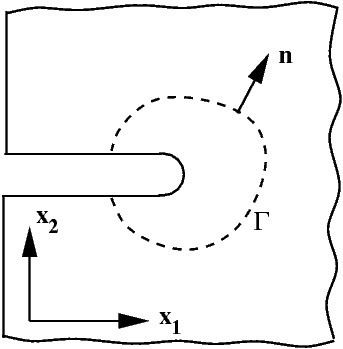 | ||
The J-integral represents a way to calculate the strain energy release rate, or work (energy) per unit fracture surface area, in a material. The theoretical concept of J-integral was developed in 1967 by Cherepanov and in 1968 by Jim Rice independently, who showed that an energetic contour path integral (called J) was independent of the path around a crack.
Contents
- Two dimensional J integral
- J integral and fracture toughness
- Elastic plastic materials and the HRR solution
- References
Later, experimental methods were developed, which allowed measurement of critical fracture properties using laboratory-scale specimens for materials in which sample sizes are too small and for which the assumptions of Linear Elastic Fracture Mechanics (LEFM) do not hold, and to infer a critical value of fracture energy JIc. The quantity JIc defines the point at which large-scale plastic yielding during propagation takes place under mode one loading.
The J-integral is equal to the strain energy release rate for a crack in a body subjected to monotonic loading. This is generally true, under quasistatic conditions, only for linear elastic materials. For materials that experience small-scale yielding at the crack tip, J can be used to compute the energy release rate under special circumstances such as monotonic loading in mode III (antiplane shear). The strain energy release rate can also be computed from J for pure power-law hardening plastic materials that undergo small-scale yielding at the crack tip.
The quantity J is not path-independent for monotonic mode I and mode II loading of elastic-plastic materials, so only a contour very close to the crack tip gives the energy release rate. Also, Rice showed that J is path-independent in plastic materials when there is no non-proportional loading. Unloading is a special case of this, but non-proportional plastic loading also invalidates the path-independence. Such non-proportional loading is the reason for the path-dependence for the in-plane loading modes on elastic-plastic materials.
Two-dimensional J-integral
The two-dimensional J-integral was originally defined as (see Figure 1 for an illustration)
where W(x1,x2) is the strain energy density, x1,x2 are the coordinate directions, t = [σ]n is the surface traction vector, n is the normal to the curve Γ, [σ] is the Cauchy stress tensor, and u is the displacement vector. The strain energy density is given by
The J-integral around a crack tip is frequently expressed in a more general form (and in index notation) as
where
Rice also showed that the value of the J-integral represents the energy release rate for planar crack growth. The J-integral was developed because of the difficulties involved in computing the stress close to a crack in a nonlinear elastic or elastic-plastic material. Rice showed that if monotonic loading was assumed (without any plastic unloading) then the J-integral could be used to compute the energy release rate of plastic materials too.
J-integral and fracture toughness
For isotropic, perfectly brittle, linear elastic materials, the J-integral can be directly related to the fracture toughness if the crack extends straight ahead with respect to its original orientation.
For plane strain, under Mode I loading conditions, this relation is
where
For Mode II loading, the relation between the J-integral and the mode II fracture toughness (
For Mode III loading, the relation is
Elastic-plastic materials and the HRR solution
Hutchinson, Rice and Rosengren subsequently showed that J characterizes the singular stress and strain fields at the tip of a crack in nonlinear (power law hardening) elastic-plastic materials where the size of the plastic zone is small compared with the crack length. Hutchinson used a material constitutive law of the form suggested by Ramberg and Osgood:
where σ is the stress in uniaxial tension, σy is a yield stress, ε is the strain, and εy = σy/E is the corresponding yield strain. The quantity E is the elastic Young's modulus of the material. The model is parametrized by α, a dimensionless constant characteristic of the material, and n, the coefficient of work hardening. This model is applicable only to situations where the stress increases monotonically, the stress components remain approximately in the same ratios as loading progresses (proportional loading), and there is no unloading.
If a far-field tensile stress σfar is applied to the body shown in the adjacent figure, the J-integral around the path Γ1 (chosen to be completely inside the elastic zone) is given by
Since the total integral around the crack vanishes and the contributions along the surface of the crack are zero, we have
If the path Γ2 is chosen such that it is inside the fully plastic domain, Hutchinson showed that
where K is a stress amplitude, (r,θ) is a polar coordinate system with origin at the crack tip, s is a constant determined from an asymptotic expansion of the stress field around the crack, and I is a dimensionless integral. The relation between the J-integrals around Γ1 and Γ2 leads to the constraint
and an expression for K in terms of the far-field stress
where β = 1 for plane stress and β = 1 − ν2 for plane strain (ν is the Poisson's ratio).
The asymptotic expansion of the stress field and the above ideas can be used to determine the stress and strain fields in terms of the J-integral:
where
These expressions indicate that J can be interpreted as a plastic analog to the stress intensity factor (K) that is used in linear elastic fracture mechanics, i.e., we can use a criterion such as J > JIc as a crack growth criterion.
